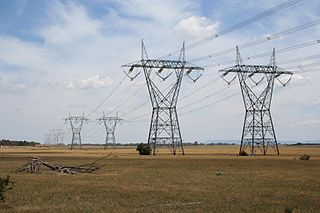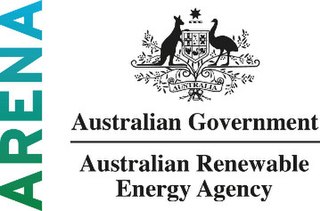
The City of Kwinana is a local government area of Western Australia. It covers an area of approximately 118 square kilometres in metropolitan Perth, and lies about 38 km south of Perth central business district, via the Kwinana Freeway. Kwinana maintains 287 km of roads and had a population of almost 39,000 as at the 2016 Census.

India is the third largest producer of electricity in the world. During the fiscal year (FY) 2022–23, the total electricity generation in the country was 1,844 TWh, of which 1,618 TWh was generated by utilities.

Verve Energy was a Western Australian Government owned corporation responsible for operating the state's electricity generators on the state's South West Interconnected System (SWIS). It was split from the then vertically integrated Western Power Corporation, in 2006 during reforms to the state's electricity sector.
Horizon Power is a commercially focused, state government-owned, power company that provides power supplies to Western Australia. It is responsible for generating, procuring, distributing and retailing electricity to residential, industrial and commercial customers and resource developments in its service area.

Synergy is a corporation owned by the Government of Western Australia. Synergy is Western Australia’s largest energy retailer and generator with more than one million industrial, commercial and residential customers, generating total annual revenue of more than $3.2 billion.
Western Power is a statutory corporation established by the Electricity Corporations Act 2005 (WA). It is owned by the State Government of Western Australia and is accountable to the Minister for Energy. It is responsible for building, maintaining and operating the electricity network within the South West Interconnected System (SWIS), the poles and wires or energy grid.

The energy policy of Australia is subject to the regulatory and fiscal influence of all three levels of government in Australia, although only the State and Federal levels determine policy for primary industries such as coal. Federal policies for energy in Australia continue to support the coal mining and natural gas industries through subsidies for fossil fuel use and production. Australia is the 10th most coal-dependent country in the world. Coal and natural gas, along with oil-based products, are currently the primary sources of Australian energy usage and the coal industry produces over 30% of Australia's total greenhouse gas emissions. In 2018 Australia was the 8th highest emitter of greenhouse gases per capita in the world.

Energy in Victoria, Australia is generated using a number of fuels or technologies, including coal, natural gas and renewable energy sources. Brown coal, historically, was the main primary energy source for the generation of electricity in the state, accounting for about 85% of electricity generation in 2008. The amount of coal-fired power has decreased significantly with the closure in 2017 of the Hazelwood power station which supplied around 20% of Victoria's electricity, and to a lesser extent with the exit of Anglesea power station in 2015. Brown coal is one of the largest contributors to Australia's total domestic greenhouse gas emissions and a source of controversy for the country. Australia is one of the highest polluters of greenhouse gas per capita in the world.

Queensland's energy policy is based on the year 2000 document called the Queensland Energy Policy: A Cleaner Energy Strategy. The Queensland Government assists energy development through the Department of Energy and Water Supply. The state is noted for its significant contribution to coal mining in Australia. The primary fuel for electricity generation in the state is coal with coal seam gas becoming a significant fuel source. Queensland has 98% of Australia's reserves of coal seam gas. An expansion of energy-intensive industries such as mining, economic growth and population growth have created increased demand for energy in Queensland.

The Western Australian gas crisis was a major disruption to natural gas supply in Western Australia, caused by the rupture of a corroded pipeline and subsequent explosion at a processing plant on Varanus Island, off the state's north west coast on 3 June 2008. The plant, operated by Apache Energy, which normally supplied a third of the state's gas, was shut down for almost two months while a detailed engineering investigation and major repairs were carried out. Gas supply from the plant partially resumed in late August. By mid-October, gas production was running at two-thirds of normal capacity, with 85% of full output restored by December 2008.

The petroleum industry in Western Australia is the largest contributor to the country's petroleum exports. Western Australia's North West Shelf (NWS) is the primary location from which production originates. Oil exports are shipped from Port Hedland.

An electrical grid is an interconnected network for electricity delivery from producers to consumers. Electrical grids vary in size and can cover whole countries or continents. It consists of:
The Australian Energy Market Operator (AEMO) performs an array of gas and electricity market, operational, development and planning functions. It manages the National Electricity Market (NEM), the Wholesale Electricity Market (WA) (WEM) and the Victorian gas transmission network. AEMO also facilitates electricity and gas full retail contestability, overseeing these retail markets in eastern and southern Australia. It is additionally responsible for national transmission planning for electricity and the establishment of a Short Term Trading Market (STTM) for gas.
Kwinana Cogeneration Plant was a cogeneration facility located 40 kilometres (25 mi) south of Perth, Western Australia that operated from 1994 to 2022. It provided steam and electrical power to the BP Australia Kwinana Oil Refinery and electricity to Synergy, the State owned generator/retailer.

The United Kingdom has a National Grid that covers most of mainland Great Britain and several of the surrounding islands, as well as some connectivity to other countries. The electrical sector supplies power at 50 Hz AC, and ~240 volts is supplied to consumers. In 2020 the electricity sector's grid supply came from 55% low-carbon power, 36.1% fossil fuelled power, and 8.4% imports. Renewable power is showing strong growth, while fossil fuel generator use in general and coal use in particular is shrinking, with historically dominant coal generators now mainly being run in winter due to pollution and costs, and contributed just 1.6% of the supply in 2020.
The South West Interconnected System (SWIS) is an electricity grid in the southwestern part of Western Australia. It extends to the coast in the south and west, to Kalbarri in the north and Kalgoorlie in the east. It is not connected to the other large Australian grids. Other parts of the state are connected to independent, smaller grids, including the larger-scale North West Interconnected System and many smaller microgrids managed by Horizon Power.

Kwinana Oil Refinery was sited on the shore of Cockburn Sound at Kwinana, near Fremantle, Western Australia. Built by the Anglo-Iranian Oil Company and completed in 1955, it was the largest oil refinery in Australia, with a capacity of 138,000 barrels per day (21,900 m3/d). It was closed by BP in March 2021 to be converted to an import-only terminal.
Bluewaters Power Station was the first privately owned, coal-fired power station in Western Australia. It was built by Griffin Energy in 2009 and is the newest coal-fired power station in Australia. The site is 4.5 km (2.8 mi) northeast of Collie.

The Australian Renewable Energy Agency (ARENA) is an independent agency of the Australian federal government, established in 2012 to manage Australia's renewable energy programs, with the objective of increasing supply and competitiveness of Australian renewable energy sources.













